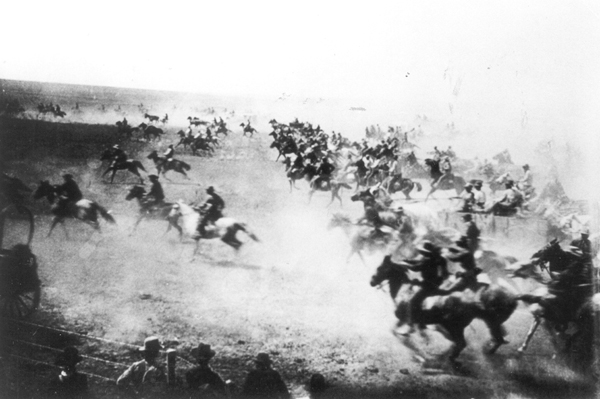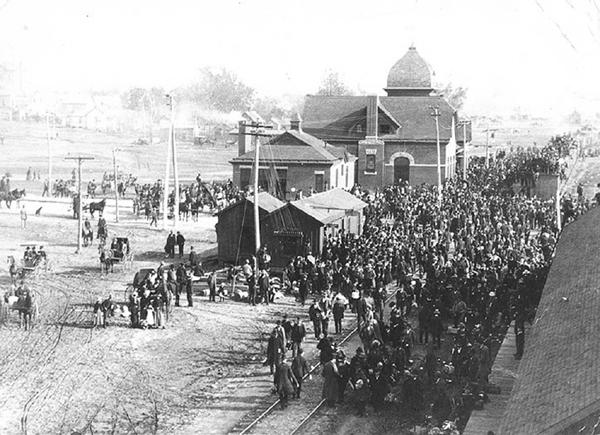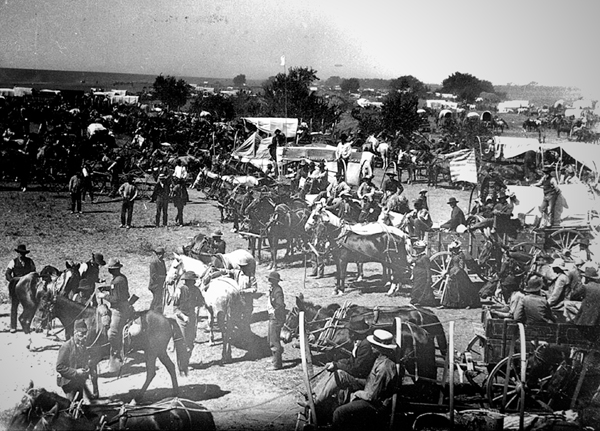Address: 31639 U.S. 77, Arkansas City, KS 67005
Phone: 620.442.6750
Website: www.arkcity.org/index.aspx?ID=216
 |
| The land rush getting ready to start. Photo courtesy Cherokee Strip Land Rush Museum |
The Cherokee Strip Land Rush Museum tells the story of the last great land rush into Indian Territory. On September 16, 1893, Arkansas City had a population of about 100,000 and upon the firing of a gun at noon the population dropped to 5000, as men, women, and children raced to claim land for their own. The Museum tells the story of those who left to claim land and those who remained behind. The Museum has earned a place in the National Park Service registry because of the importance and significance of this event.
 |
| The race is on! Photo courtesy Cherokee Strip Land Rush Museum |
The Cherokee were given the eastern part of their land to live on and the western remainder all the way to the west was known as the Cherokee Outlet because it was to be their outlet to hunting grounds, which they never used due to the fact that they were horticulturists. So, they leased much of the western portion of their land to cattlemen for grazing.
After the Civil War, much of their land in the middle of the outlet was given to other tribes as punishment for their participation in the war on the side of the Confederacy. Their land became split in two with the Osage, Kaw, and Pawnee in the center of the Cherokee Outlet. The western portion of their land was leased to the Cherokee Strip Livestock Association for many years.
Beginning in 1870, David Payne led boomers in an effort to open Indian Territory for settlement by white settlers. He was successful in opening the "Unassigned Lands" in the 1889 land rush. After that, he began to concentrate on opening the Cherokee Outlet. Unfortunately, he passed away before he could bring his plans to fruition. However, his group of Boomers did not deter. In 1890, President, Benjamin Harrison proclaimed the Cherokee Strip public domain through a Congressional bill. When this happened the community of Arkansas City became desolate, because men and women packed up and drove down to the Cherokee Outlet to stake claims and build town sites. Unfortunately for them, the official opening of the land wasn't until 1893. Between 1891 and 1893, boomer camps began to pop up along the rivers in communities like Arkansas City in anticipation of the opening of the Cherokee Outlet.
 |
| People arriving for the race. Photo courtesy Cherokee Strip Land Rush Museum |
This prompted the Cherokee Strip Livestock Association to try to purchase the Outlet from the Cherokee. However, the government declared the new agreement void and paid the Cherokee a portion of what the Cherokee Strip Livestock Association was willing to pay. The
THE LAND RUSH
September 16, 1893 was chosen as the date for the land to be opened up for settlement by having a great land race for the land. Even more settlers began to pour into the area vying for a relatively free piece of land. The nation was having an economic panic and there was a drought on, therefore more and more people were looking for a fresh start in a new land.
People stood in line for days to register and get their forms and flags in order to race. Many Arkansas Citians took advantage of the weather conditions and brought water to sell to potential claim stakers for $1 per jar, which they gladly paid because it was so dry and hot. After the boomers signed up for the race, they waited for the starting date, September 16, 1893 at noon.
 |
| Huge crowd of people waiting for the race to begin. Photo courtesy Cherokee Strip Land Rush Museum |
The lines for the run consisted of bicycles, people on foot, buggies, light contraptions, wagons, horses and even a train. The train was allowed to travel at the speed of a horse and people jumped off of the train when they found their land. It was a great chaotic race, but people found it worth it to get their quarter section of land. After this, the largest land race in the history of
Source:
 |
THE MUSEUM
The
Monday and Tuesday - Closed. Wednesday-Saturday 10am-5pm; Sunday 1-4pm
Admission charge: Adults $4.50; Seniors $3.50; children 6-12 $2